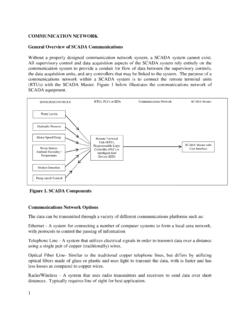Transcription of History of Mobile Applications - University of Kentucky
1 History of Mobile Applications MAS 490: Theory and Practice of Mobile Applications Professor John F. Clark overview Mobile communication is so integrated into our lives that many people feel uncomfortable without a cell phone. Once upon a time, the most popular functions of phones were calling and sending texts. A smart phone is a multifunctional device that not only communicates, but helps to learn, earn, and have fun. This is made possible by the development of Mobile Applications . overview , cont. Mobile Applications date back to the end of the twentieth century. Typically, they were small arcade games, ring tone editors, calculators, calendars, and so forth. The beginning of the new millennium saw a rapid market evolution of Mobile content and Applications .
2 Operating systems for smart phones (Windows Mobile , Symbian, RIM, Android, Mac iOS), are open to the development of third-party software, unlike the conventional programming environment of standard cell phones. overview , cont. Manufacturers tried to make their products more attractive for customers by introducing more and more Applications . But quality matters as well. Cell phone development needs to be easy and intuitive. Every company tries to facilitate the process of development so that users are able to customize their devices. Motivation: Juniper Research estimates in 2014 the direct and indirect revenues from sales of Mobile Applications will total 25 billion dollars. So, to conclude: Mobile users demand more choice, more opportunities to customize their phones, and more functionality Mobile operators want to provide value-added content to their subscribers in a manageable and lucrative way.
3 Mobile developers want the freedom to develop the powerful Mobile Applications users demand without restrictions. Finally, handset manufacturers want a stable, secure, and affordable platform to power their devices. Remember the Brick? Remember the Brick? The Motorola DynaTAC 8000X was the first commercially available cell phone. First marketed in 1983, it was 13 x x inches in dimension, weighed about pounds, and allowed you to talk for a little more than half an hour. It retailed for $3,995, plus hefty monthly service fees and per-minute charges. It made calls, and there was a simple contacts application included in the operating system. History : the first apps First-generation Mobile phones were designed and developed by the handset manufacturers.
4 Competition was fierce and trade secrets were closely guarded. They didn t want to expose the secrets of their handsets, so they developed the phone software in-house. Developers that weren t part of this inner circle had no opportunity to write Applications for the phones. History : the first apps It was during this period the first time-waster games begin to appear. Nokia was famous for putting the 1970s video game Snake on some of its earliest phones. Other followed, adding games like Pong, Tetris, and Tic-Ta c-Toe. These early phones changed the way people thought about communication. As Mobile phone prices dropped, batteries improved, reception areas grew, and more and more people began carrying these handy devices. Soon Mobile phones were more than just a novelty.
5 History : the first apps Customers began pushing for more features and more games. But handset manufacturers didn t have the motivation or the resources to build every application users wanted. They needed some way to provide a portal for entertainment and information services without allowing direct access to the handset. What better way to provide these services than the Internet? History : We Need WAP It turned out direct phone access to the Internet didn t scale well for Mobile . By the late 90s, professional Web sites were full color and loaded with text, images, and other types of media. They relied on JavaScript and Flash to enhance the user experience and were often designed at 800 600 pixels. Early phones had very small monochrome low-res screens and limited storage and processing power.
6 They couldn t handle the data-intensive operations required by traditional Web browsers. The bandwidth requirements for data transmission were also costly to the user. 1G Cell Phones History : WAP is the answer! The Wireless Application Protocol (WAP) standard was developed to address these concerns. WAP was a stripped-down version of HTTP, which is the basic protocol of the World Wide Web. WAP browsers were designed to run within the memory and bandwidth constraints of the phone. Third-party WAP sites served up pages written in a markup language called Wireless Markup Language (WML). The pages were much simpler in design than the WWW pages. History : WAP is the answer! The WAP solution was great for handset manufacturers. They could write one WAP browser to ship with the handset and rely on developers to come up with the content users wanted.
7 The WAP solution was great for Mobile operators. They could provide a custom WAP portal directing their subscribers to the content they wanted to provide, and wallow in the high data charges associated with browsing. But there was one problem History : Is WAP the answer? Developers and content providers didn t deliver, except in a limited way. Most of the early WAP sites were extensions of popular branded Web sites, such as and Users accessed the news, stock market quotes, and sports scores on their phones. Some of the most popular commercial WAP Applications that emerged during this time were simple wallpaper and ring tone catalogues, allowing users to personalize their phones for the first time. History : WAP is not the answer! Commercializing WAP Applications was difficult, and there was no built-in billing mechanism.
8 Users browsed a WAP site and requested a specific item, then filled out a simple order form with their phone number and the handset model of their phone. It was up to the content provider to deliver an image or audio file compatible with the phone. Payment was handled through various premium-priced delivery mechanisms such as Short Message Service (SMS), Enhanced Messaging Service (EMS), Multimedia Messaging Service (MMS), and WAP Push. History : WAP is not the answer! WAP browsers were slow and frustrating. Typing in long URLs with the numeric keypad was a tremendous pain. Most WAP sites were one version and did not account for individual phone specifications. It didn t matter if the end-user s phone had a big color screen or a postage stamp-sized monochrome one.
9 The developer couldn t tailor the user s experience. The result was a mediocre and not very compelling experience for everyone involved. History : WAP is not the answer! WAP fell short of commercial expectations, except in Japan and a few other places. Small handset screens were too small for surfing. Reading a sentence fragment at a time and then waiting seconds for the next segment to download ruined the user experience, especially because every second of downloading was charged to the user. Critics began to call WAP Wait and Pay. It came as no surprise when users wanted more they will always want more. Proprietary Mobile Platforms Writing graphic-intensive video game Applications with WAP was nearly impossible The kids most likely to personalize their phones with wallpapers and ring tones looked at their portable gaming systems and asked for a device that was both a phone and a gaming device or a phone and a music player.
10 If devices like Nintendo s Game Boy could provide hours of entertainment with only five buttons, why not just add phone capabilities? Proprietary Mobile Platforms Memory was getting cheaper; batteries were getting better; and PDAs and other embedded devices were beginning to run compact versions of common operating systems like Linux and Windows. The traditional desktop application developer was suddenly involved in the embedded device market, especially with Smartphone technologies like Windows Mobile , which they found familiar. Handset manufacturers realized that if they wanted to continue to sell their products, they needed to change their protectionist policies regarding handset design and expose their internal workings to some extent. Proprietary Mobile Platforms A variety of different proprietary platforms emerged and developers are still actively creating Applications for them.

















